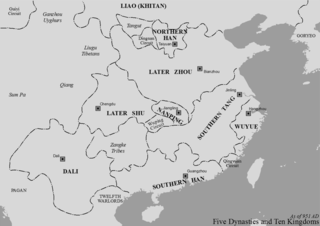Later Shu
Shu (referred to as Later Shu (simplified Chinese: 后蜀; traditional Chinese: 後蜀; pinyin: Hòu Shǔ) to differentiate it from other states named Shu in Chinese history), also known as Meng Shu (Chinese: 孟蜀), was one of the Ten Kingdoms during the Five Dynasties and Ten Kingdoms period in China. It was located in present-day Sichuan with its capital in Chengdu and lasted from 934 to 965. It was the fourth and latest state of this name on the same territory.
Hòu Shǔ 后蜀 / trad. 後蜀 | |||||||||
|---|---|---|---|---|---|---|---|---|---|
| 934–965 | |||||||||
 Later Shu shown in light red | |||||||||
| Capital | Chengdu | ||||||||
| Common languages | Ba-Shu Chinese | ||||||||
| Government | Monarchy | ||||||||
| Emperor | |||||||||
• 934 | Emperor Gaozu | ||||||||
• 934–965 | Emperor Houzhu | ||||||||
| Historical era | Five Dynasties and Ten Kingdoms Period | ||||||||
• Established in Chengdu | 934 934 | ||||||||
• Surrendered to Song | 965 965 | ||||||||
| |||||||||
| Today part of | China | ||||||||
Background and founding
The other Shu kingdom of the Five Dynasties and Ten Kingdoms period, today known as the Former Shu, was founded in 907 after the end of the Tang dynasty. It was conquered in 925 by the Later Tang, the second of the five dynasties that would rule the Central Plain during this period.
Meng Zhixiang, one of the Later Tang military governors assigned to the conquered Shu territories, became remarkably powerful in the years following the invasion. In 930 he entered into open rebellion with fellow military governor Dong Zhang; although their rebellion was initially successful, Meng wished to submit once more to the rule of the Later Tang and so in 932 the two rebel leaders turned on each other. Meng defeated Dong and, in addition to taking control of Dong's lands, was given even greater authority than before by the Later Tang government. This arrangement did not last long: in December of 933 the emperor Li Siyuan died of an illness and was succeeded by the 19-year-old Li Conghou, and in the spring of 934 Meng declared himself the Emperor of a newly independent Shu.
Territorial Extent
The Later Shu kingdom held essentially the same territory as the Former Shu kingdom. The kingdom held most of present-day Sichuan, along with southern Gansu and Shaanxi, western Hubei and all of present-day Chongqing. As with the Former Shu, the capital of the kingdom was at Chengdu.
Succession
Meng Zhixiang died less than a year after declaring himself emperor of Shu. His son Meng Chang ruled for thirty years until the kingdom was invaded by and incorporated into the expanding Song empire in 965.
Rulers of the Later Shu
| Temple name | Posthumous name | Family name and given name | Reign | Era names and their corresponding years | |||||
|---|---|---|---|---|---|---|---|---|---|
| 高祖 | Emperor Wénwǔ Shèngdé Yīngliè Míngxiào (文武聖德英烈明孝皇帝) | Mèng Zhīxíang (孟知祥) | 934 | Míngdé (明德) 934 | |||||
| 後主 | Prince Gongxiao of Chu (楚恭孝王) | Mèng Chǎng (孟昶) | 934–965 | Míngdé (明德) 934–938 Guǎngzhèng (廣政) 938–965 | |||||
Rulers family tree
| Later Shu | ||||||||||||||||||||||||||||||||||||||||||||||||||||||||||||||||||||||||||||||||||||||||||||||||||||||||||||||||||||||||||
|---|---|---|---|---|---|---|---|---|---|---|---|---|---|---|---|---|---|---|---|---|---|---|---|---|---|---|---|---|---|---|---|---|---|---|---|---|---|---|---|---|---|---|---|---|---|---|---|---|---|---|---|---|---|---|---|---|---|---|---|---|---|---|---|---|---|---|---|---|---|---|---|---|---|---|---|---|---|---|---|---|---|---|---|---|---|---|---|---|---|---|---|---|---|---|---|---|---|---|---|---|---|---|---|---|---|---|---|---|---|---|---|---|---|---|---|---|---|---|---|---|---|---|
| ||||||||||||||||||||||||||||||||||||||||||||||||||||||||||||||||||||||||||||||||||||||||||||||||||||||||||||||||||||||||||
References
- Mote, F.W. (1999). Imperial China (900-1800). Harvard University Press. pp. 11–15. ISBN 0-674-01212-7.
External links
- Chinaknowledge.de: Tang/rulers-houshu(in German)